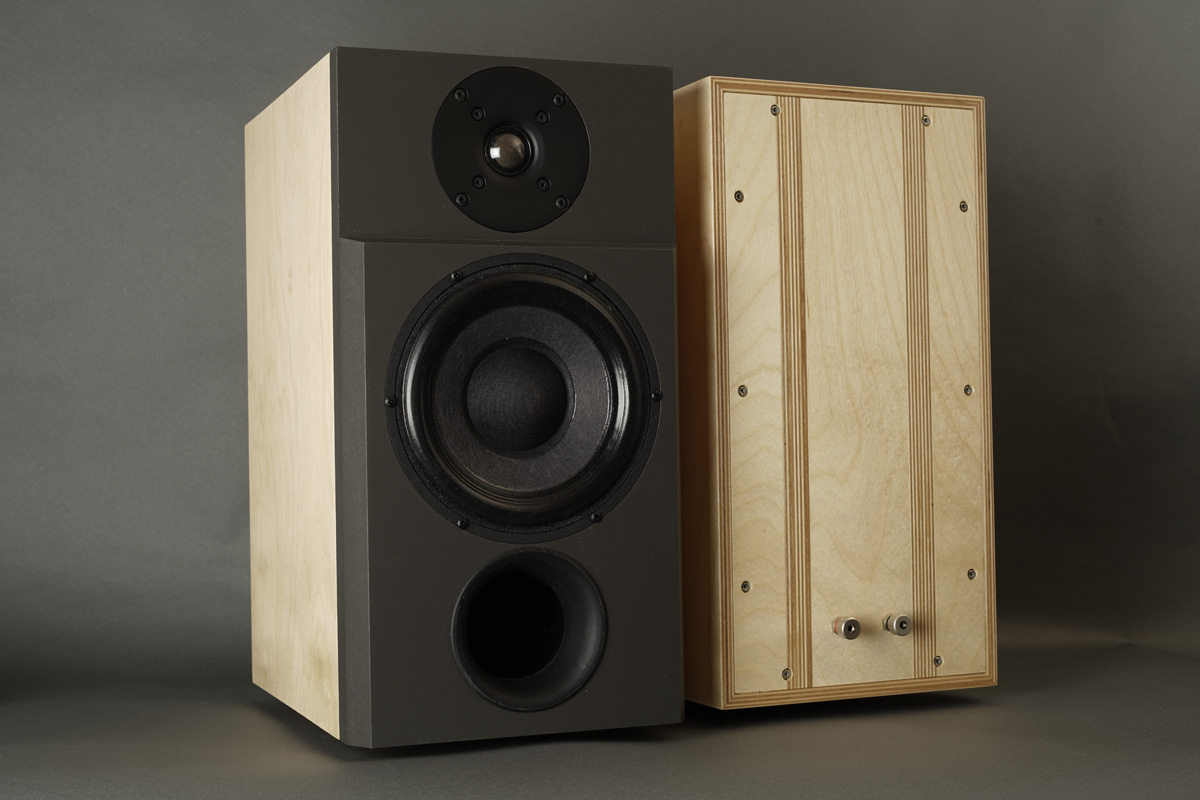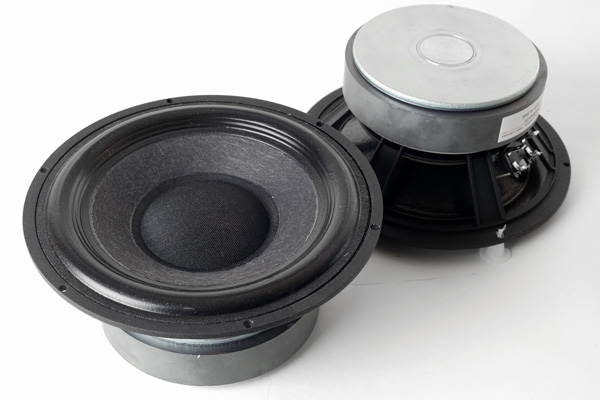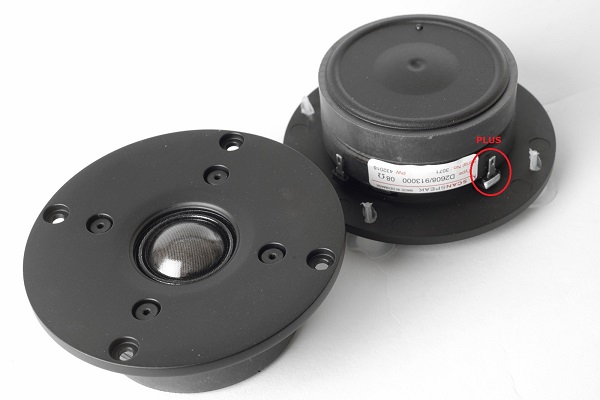DIY Loudspeakers: HOME INDEX UPDATES RESPONSE WHAT'S NEW
ScanSpeak Studio 101 mkII
Copyright 2019-21 © Troels Gravesen
Go to on this page:
DRIVERS
CROSSOVER CABINET
WORKSHOP PICS
MEASUREMENTS
SPEAKER-KIT
CROSSOVER LAYOUT BASS
MODULE
Making an mkII version of the popular Studio 101 has been on my to-do
list for a long time. The
Studio 101 has sold steadily over the years and here's an updated
version with an updated 18W woofer, better tweeter and optimised
crossover.
There are classic drivers that don't change much over the years. The
18W/8542-00 is such a driver featuring a cone similar in composition to
my 8008-HMQ driver. The 18W/8542-00 has gotten a brush up since
last time, new alu chassis, a more thorough coating of the surround and
damping of the center pole piece producing an overall flatter response
and smoother roll-off. Overall the edge coating suggests some experience from the 18WE driver is
carried over to this driver. All very welcome. Now 18W/8542-10.
I've praised the D2608/913000 tweeter before, and
this tweeter in terms of quality belongs in one of the higher categories
among ScanSpeak tweeters. Here's a test of the D2608/913000 tweeter and
compared to D3004/660000 tweeter. Link
here.
In had high hopes for the 18W/8542-10 and I wasn't disappointed. Kind of
sound I'd gotten used to from the Ellipticor 18WE driver. Not as
extended as the 18WE driver but this can sometimes be an advantage
depending on what type of crossover we use. What matters is that there
are no peaks in the treble area than interferes with tweeter
performance. The dip at 4.5 kHz doesn't matter being one octave above
point of crossover. Dips can be very hard to hear contrary to peaks and
here we are not in any trouble zone.
I know the 9130 tweeter very well from other constructions, so no
surprise here. Transparent and smooth treble performance. Coming from the Ellipticor-3
takes some mental adjustments as we just don't have some 500+ sqcm
membrane area for bass, but we get used to it. Not having the deep bass
will focus our attention to midrange and treble and they better deliver.
I many ways it's harder to make a small speaker than a big one. It takes
careful fine-tuning all over the frequency range.
I have tried combining the STUDIO 101 mkII with a 10" Faital 10RS350 bass driver in a vented 34 litre cabinet driven by a Hypex FA251 and it all of a sudden turns the speaker into a powerful 2-way + sub. The 18W/8542-10 can handle quite some power and again, like the ATELL-3, I have decided not to ad any high-pass filter to the driver. I has its benefits. The FA251 can be driven from the speaker cables, so no line signal needed, only an extra power cord. Go to bottom of page.
Basics:
2-way speaker from 7" midbass and 1" dome tweeter.
Crossover: 2nd order LR2
Dimensions: 22 x 30.5/34.5 x 42 cm, WxDxH.
System sensitivity: 86-87 dB/2.8V/1 meter.
Impedance: 8 Ohms, minimum 6 Ohm at 4 kHz.
Point of crossover: 2300 Hz.
Power requirement: 20+ watts/channel.
Power handling: 100 watts. Please
also read:
http://www.troelsgravesen.dk/power-handling.htm,
and remember any burned driver is a misused driver.
Useful links:
http://www.troelsgravesen.dk/tips.htm
http://www.troelsgravesen.dk/crossovers.htm
http://www.troelsgravesen.dk/LCR-RC.htm
FAQ:
You cannot change cabinet front panel dimensions and drivers' placement
without needing a new crossover - and I cannot help.
You cannot use any other drivers with the crossover shown here.
Please read these files before e-mailing:
http://www.troelsgravesen.dk/crossovers.htm
http://www.troelsgravesen.dk/choices.htm
Download specs here: 18W/8542-10 D2608/913000
(the terminal marked with grey paint on the 9130 tweeter is PLUS)
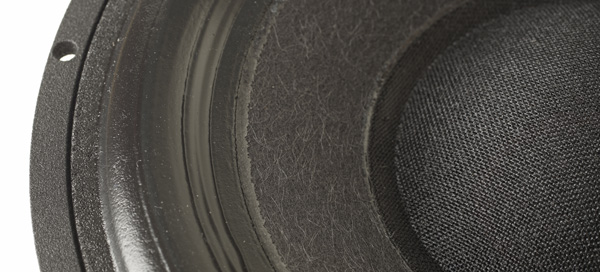
Seems the 8542 has gotten a ring of coating/damping material to increase mass at
the transition from cone to surround.
On top of this a full-cover coating of the foam surround. The surround
is also coated on the rear side.
Finally the center pole piece has gotten a felt pad, improving the
high-frequency roll-off.
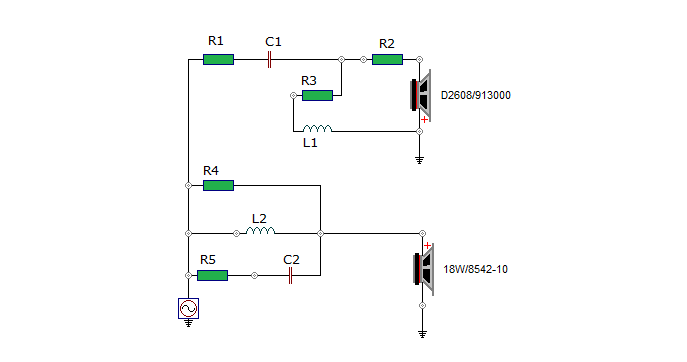
Those familiar with the mkI version may notice a simpler crossover
for the 18W/8542-10 driver.
Link to mkI. Here we feature a simple LR2 filter. Due to the advanced edge coating of the new 8542, we
don't have any upper-mid bump we need to eliminate with a notch-filter
and the inherent roll-off is nicer compared to the old 8542. R4 shapes
the 8542 roll-off together with L2 and R5 and C2 takes care of a little
too much energy in the treble range.
Tweeter crossover is simplified too, eliminating an RC circuit. A simple
LR2 filter creates the target roll-off.
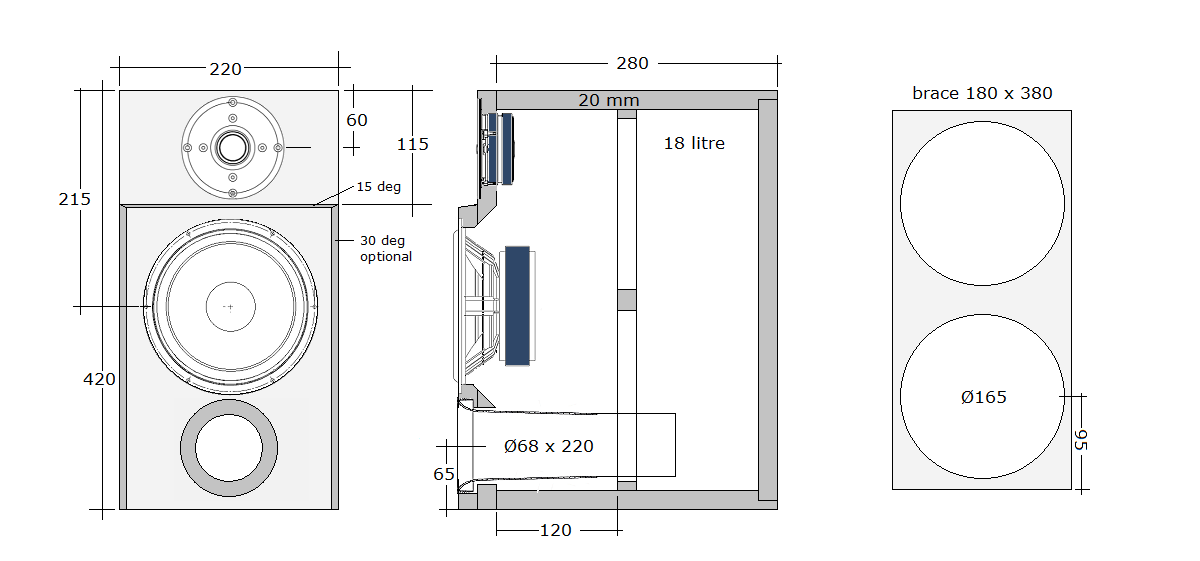
Cabinet almost as simple as can be. Rectangular box with one
vertical brace. Front panels made from 20 mm MDF/HDF. You can make the cabs
from 19-22 mm HDF/MDF or 20 mm Baltic birch. If you use 22 mm overall increase
depth by 10 mm.
Port can be to the front or the back. If I put it one way, I immediately
have the question whether it can be the other way, so the choice is
yours.
Port is Ø68 x 220 mm. Fairly big, but I think 50 mm is too small. Better
too big than too small to prevent any port noise.
Outer front panel: Chamfer driver hole 45 deg. to ~12 mm depth. Inner
front panel, route 182 mm hole and chamfer ~12 mm depth.
Cabinet damping:
Add 4 mm bitumen pads to sides, top and bottom panels. Se image below.
Add 8 mm felt to sides, top and bottom panels. See image below.
Fold a piece of 50 x 12 cm acoustilux and place behind tweeter against
top panel.
Add two layers of acoustilux 50 x 20 cm op top of
crossover on rear panel and against top panel.
As always: Any change to front panel dimensions or drivers' placement and you need a new crossover - and I can't help.
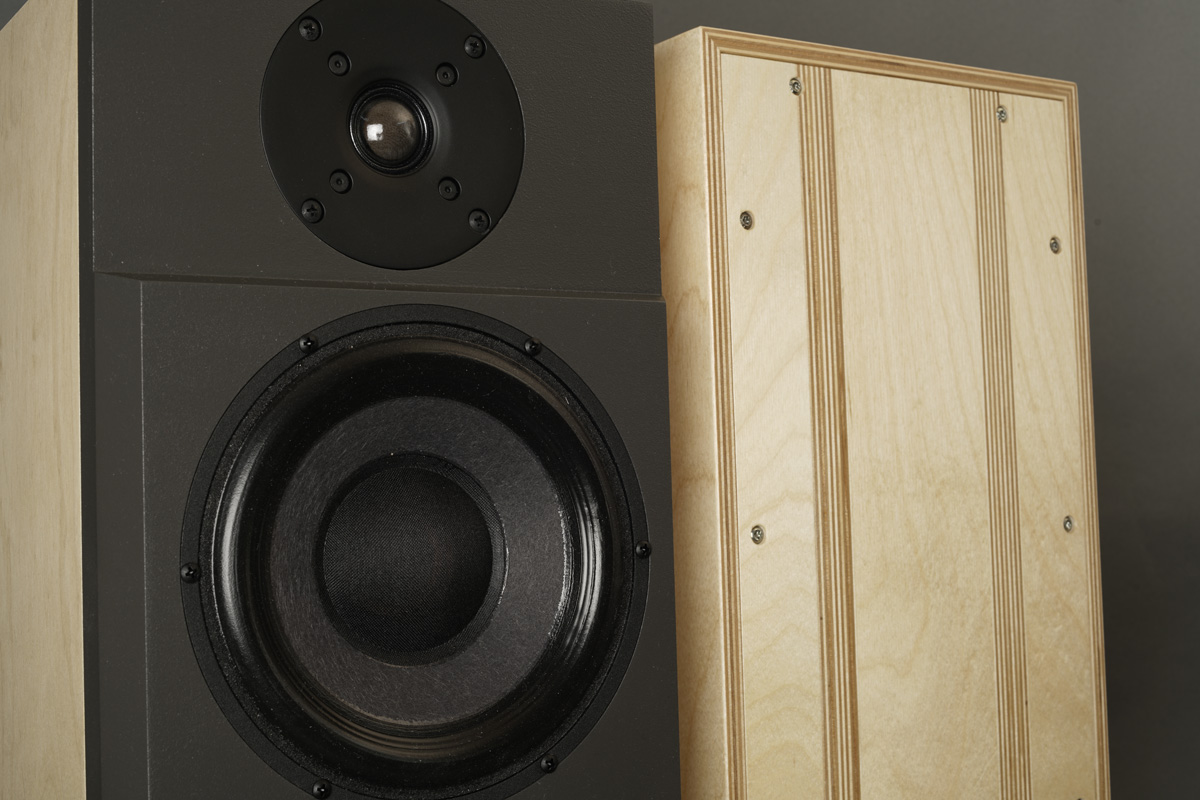
I just love building small cabinets !
Making braces, holes Ø165 mm.
Cabs were assembled with tape alone. Make sure corners are right-angled.
Use strong flexible tape if this is what you do.
All outer panels were given a thick layer of lacquer before cutting to
size. This prevents - to some extent - edge ripping and it prevents
excessive glue penetrating the outer layer of veneer and making spots in
the final finishing.

I had trouble with one cabinet not being right-angled,
thus the above arrangement during curing. Just needed a 1 mm squeeze.
Routing for the port - and front panels pretty much finished.
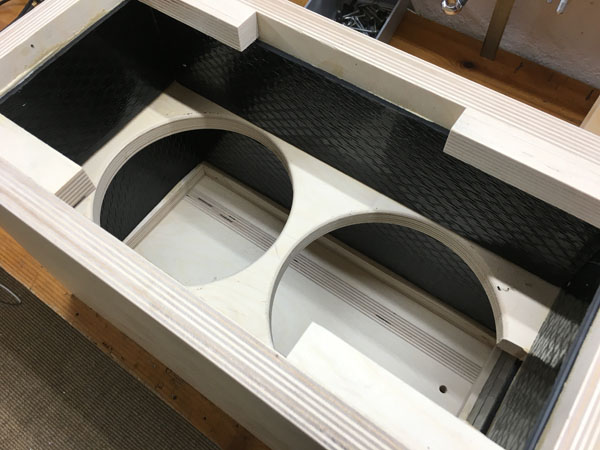
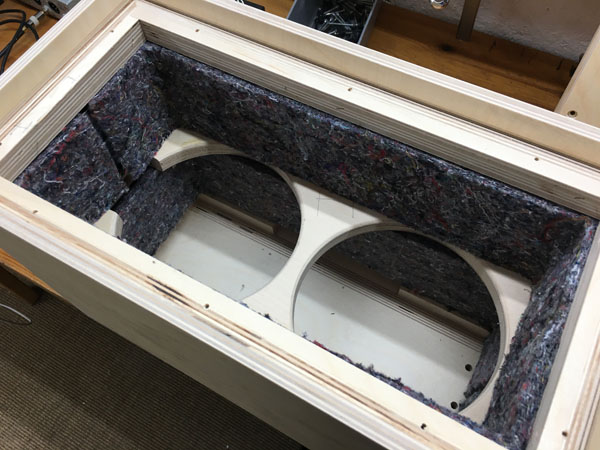
Left: Bitumen pads in place. Use
vinyl glue. Right: Felt in place. Fasten also with vinyl glue.
The bitumen pads are optional and must be added to your order.
Disregard the fillets at corners to the front. I had to use the cabinets
for more front panels.
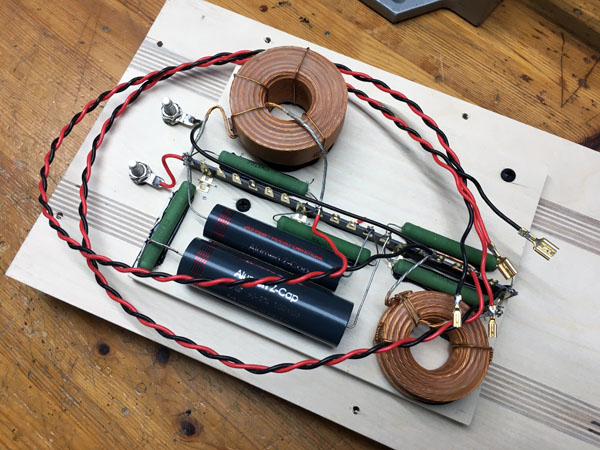
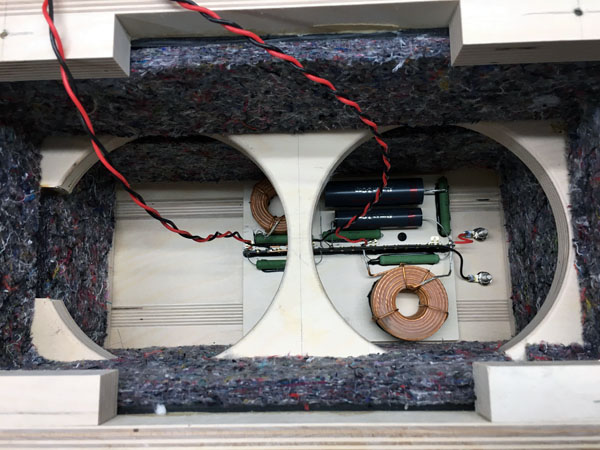
Crossover mounted on rear panel. Add felt above crossover on rear panel.
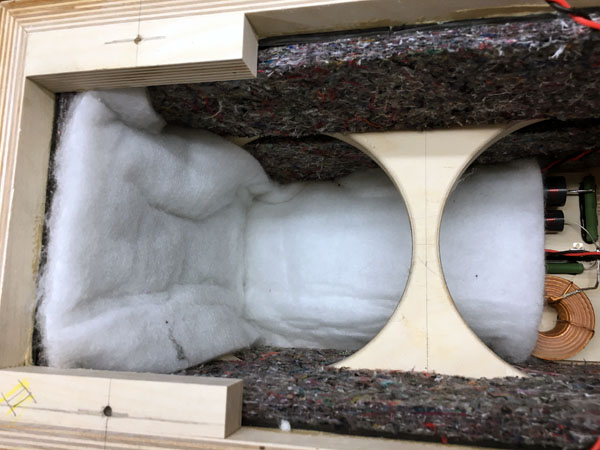
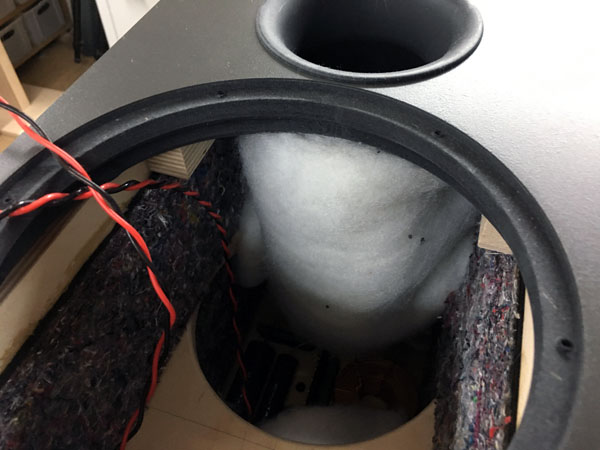
Cut a piece of 16 x 50 cm Acoustilux and place toward top and rear panel
as seen on photo.
Cut an fold a piece of 14 x 50 cm Acoustilux and place around port as
seen on photo.
That's all for damping.
A few comments on MEASUREMENTS before you start
interpreting the readings below.
First of all, if we think measurements will tell us how a speaker
sounds, we're wrong. The perception of sound is way too subjective to be
reflected in any measurements we can perform. A loudspeaker system is
meant to give us a satisfying idea of an acoustic event and for some
people a pair of 5 USD ear-plugs are enough, others spend 200 kUSD on a
truly full-range pair of speakers - and the latter may not be happier
than the former.
Measurements may give us an idea of tonal balance of a system, i.e. too
much or too little energy in certain areas, although dispersion
characteristics play a vital role here. A two-way 7+1 and a three-way
7+4+1 may display similar horizontal dispersion, yet sound very
different. Measurements may tell us about bass extension if far-field
measurements are merged with near-field measurements. In addition to
this, ports may contribute to bass extension. Most of we diy'ers do not
have access to an anechoic room for full-range measurements from
20-20000 Hz.
What cannot be seen is what kind of bass performance we get in a given
room. Bass performance is highly dependent on in-room placement of your
speaker and the same speaker can be boomy in one place and lean in
another. Actual SPL level at 1 meter distance and 2.8V input is useful
for en estimate of system sensitivity and combined with the impedance
profile may give an idea of how powerful an amplifier is needed to drive
the speaker to adequate levels.
What measurements do not tell is the very sound of the speaker unless
displaying serious linear distortion. The level of transparency, the
ability to resolve micro-details, the "speed" of the bass, etc., cannot
be derived from these data. Distortion measurements rarely tell much
unless seriously bad, and most modern drivers display low distortion
within their specified operating range.
Many people put way too much into these graphs and my comments here are
only meant as warning against over-interpretation. There are more to
good sound than what can be extracted from a few graphs. Every graph
needs interpretation in terms of what it means sonically and how it
impacts our choice of mating drivers, cabinet and crossover design.
What measurements certainly do not tell is the sonic signature of the
speaker, because speaker cones made from polypropylene, aluminum,
Kevlar, paper, glass fiber, carbon fiber, magnesium, ceramics or even
diamonds all have their way of adding spices to the stew. Nor do
measurements tell what impact the quality of the crossover components
add to the sound, from state of the art components to the cheapest of
coils and caps, they all measure the same if values are correct, yet
sound very different.
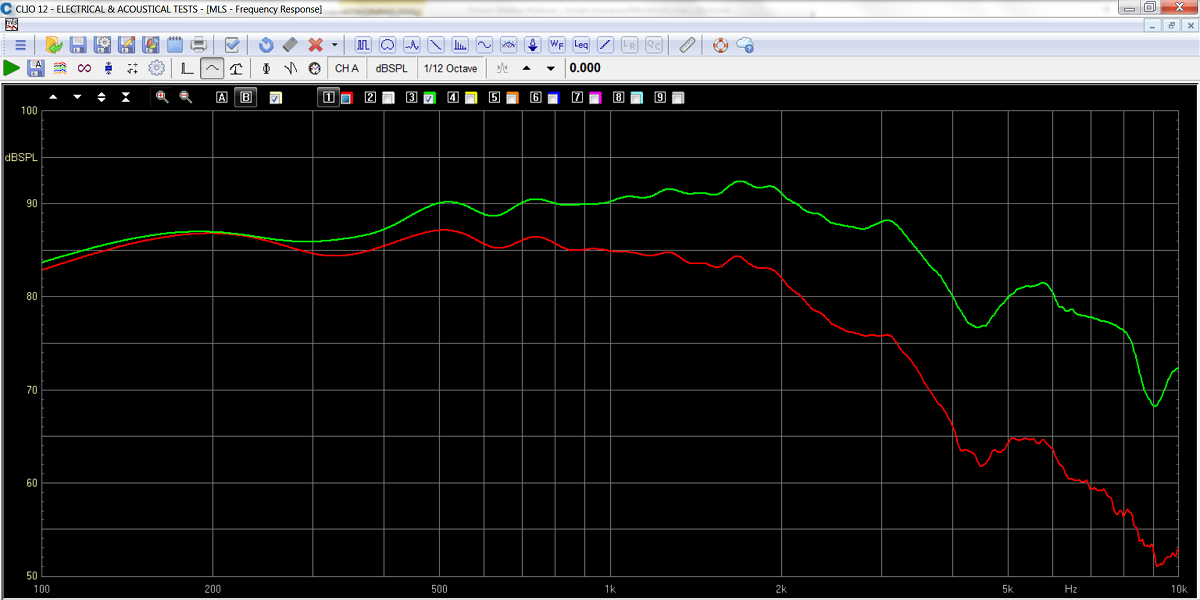
SPL of 18W/8542-10 on actual baffle. Green =
no crossover attached. Red = from 1.8 mH coil. Easy driver!
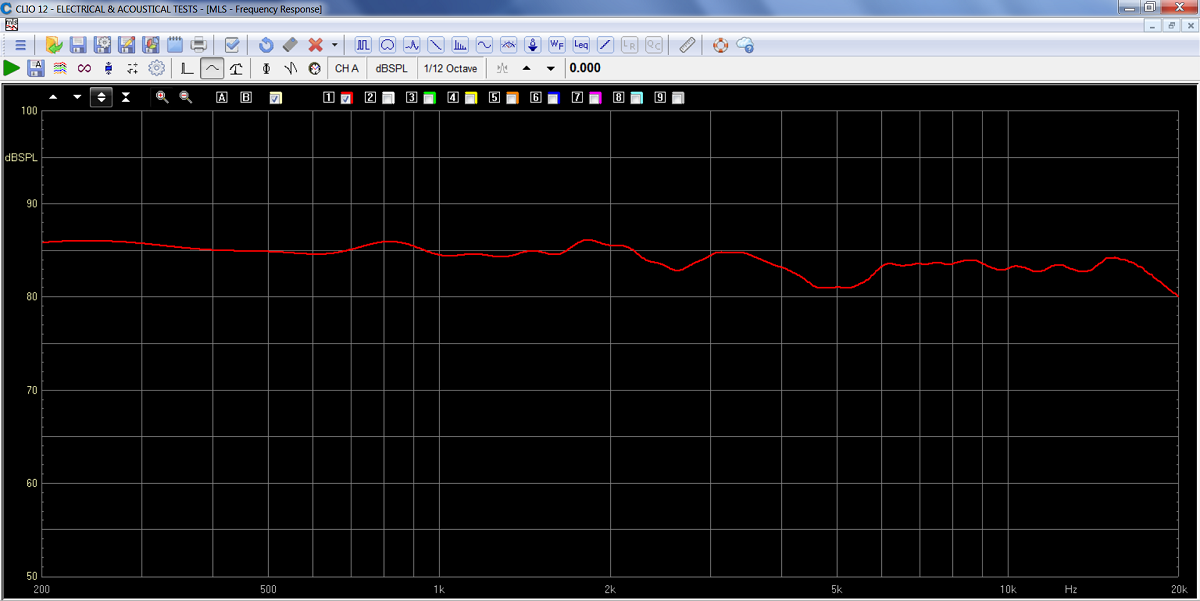
Final system response driven from crossover.
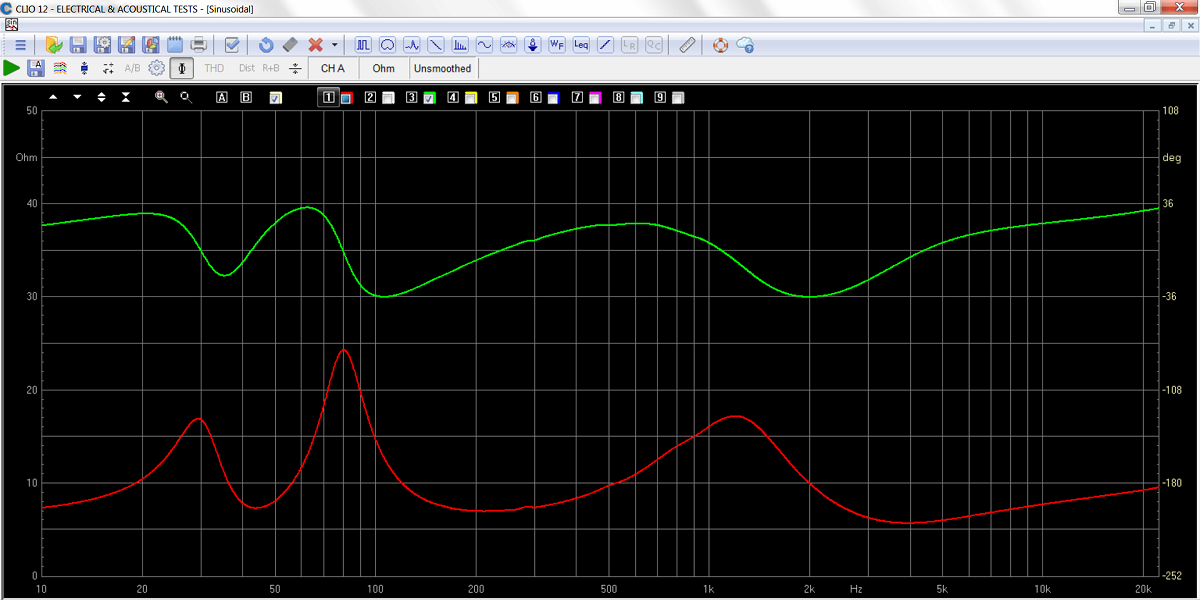
Final system impedance. Basically an 8 Ohm speaker, 7 Ohms @ 200 Hz and
min. 6 Ohms @ 4 kHz.
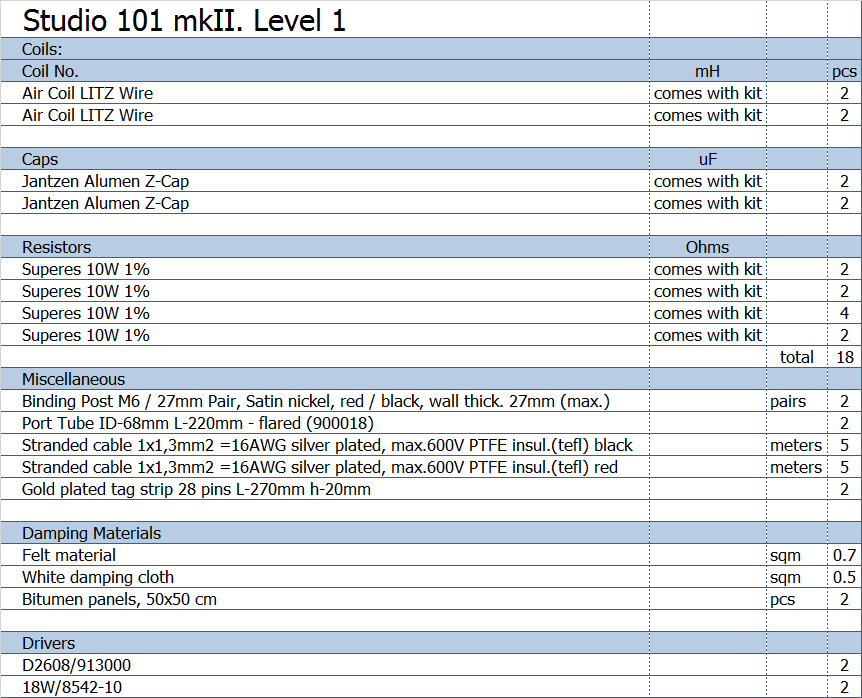
The bitumen pads are optional and
must be added to your order.
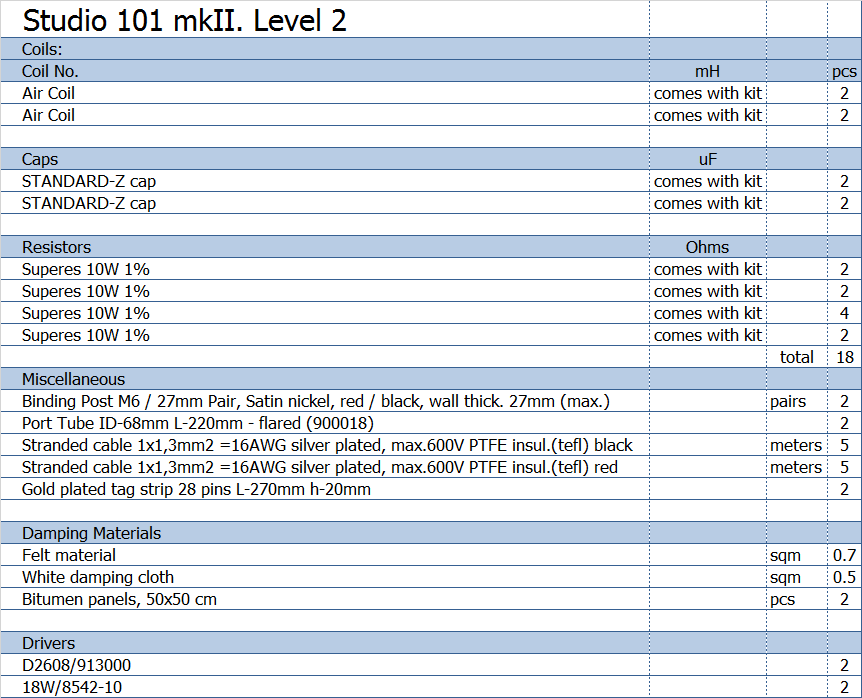
The bitumen pads are optional and must be added to your order.
Level 2 is an absolute economy version, not revealing what drivers can really do.
All kit and component prices may be subject to change and are always to be confirmed by Jantzen Audio Denmark.
Download Kit
Sale Presentations:
All technical questions to troels.gravesen@hotmail.com
All questions regarding purchase of kits, please mail Jantzen Audio at contact@jantzen-audio.com
CROSSOVER-LAYOUT
BACK TO INDEX
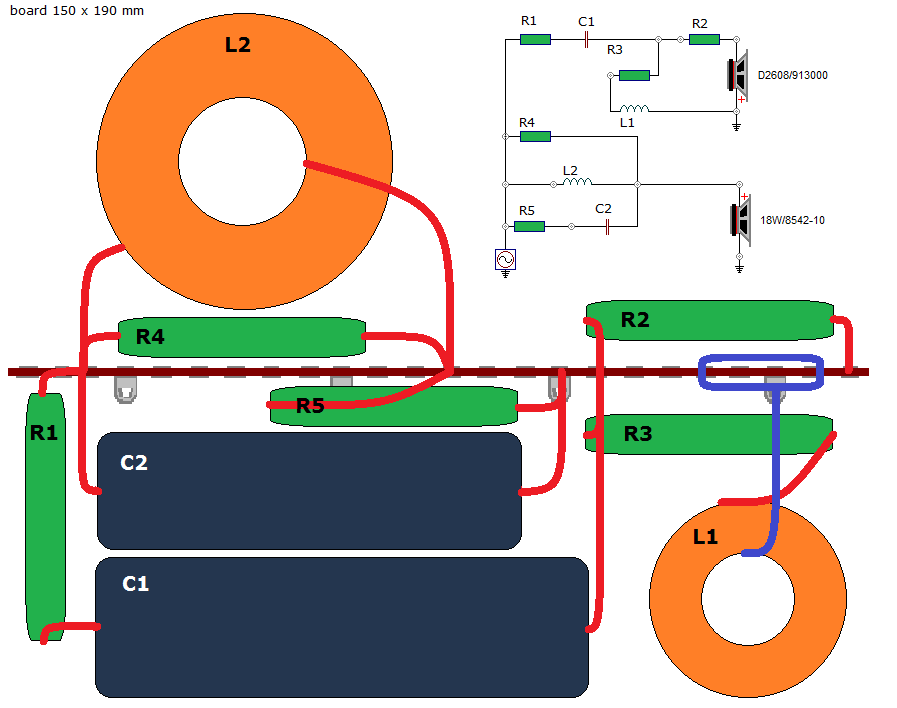
Please read this file before mail: http://www.troelsgravesen.dk/LCR-RC.htm
Speaker wiring:
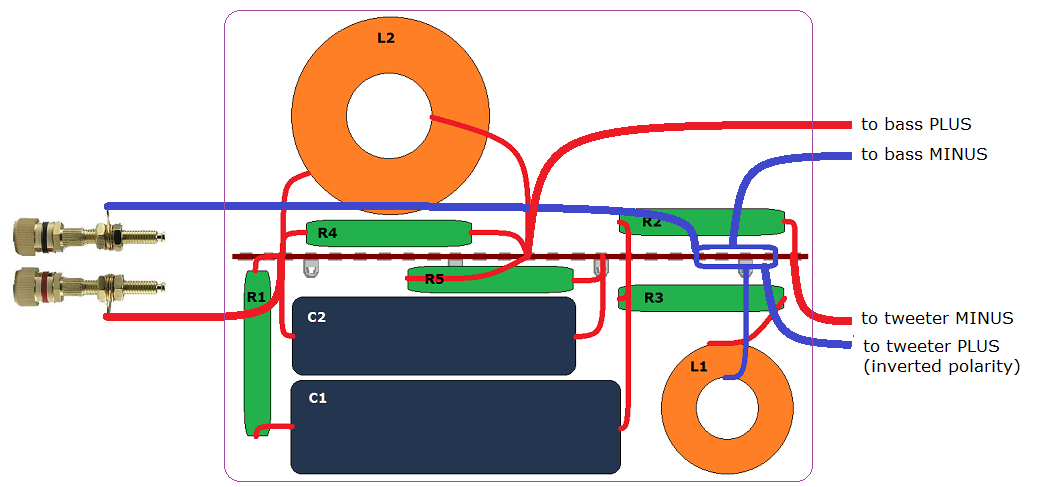
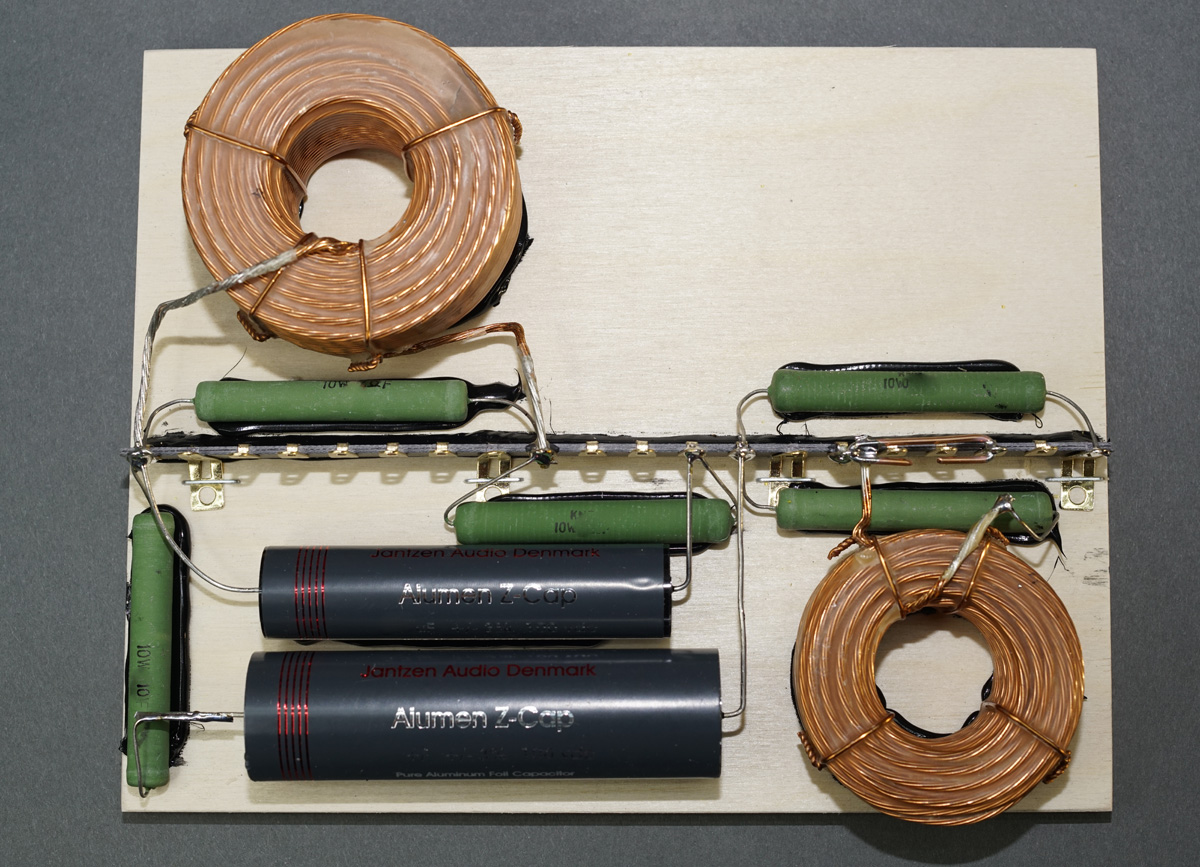
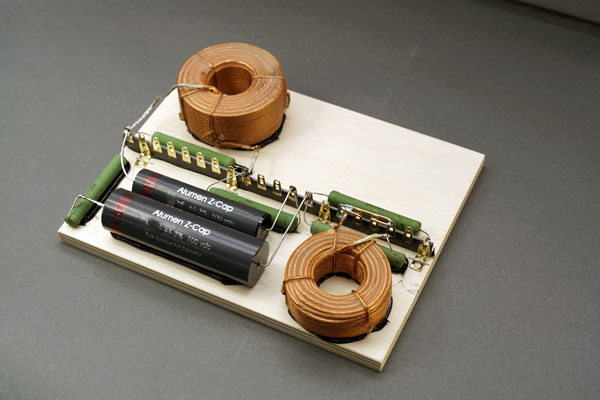
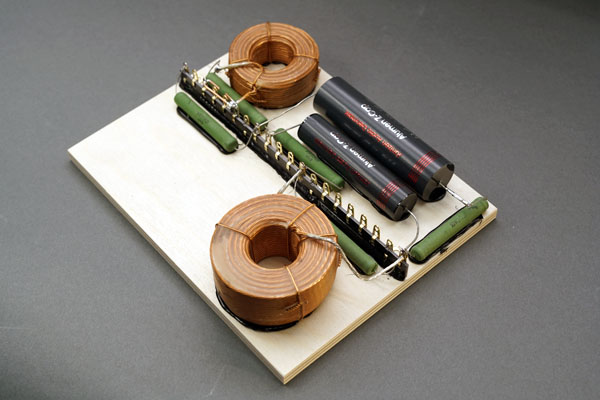
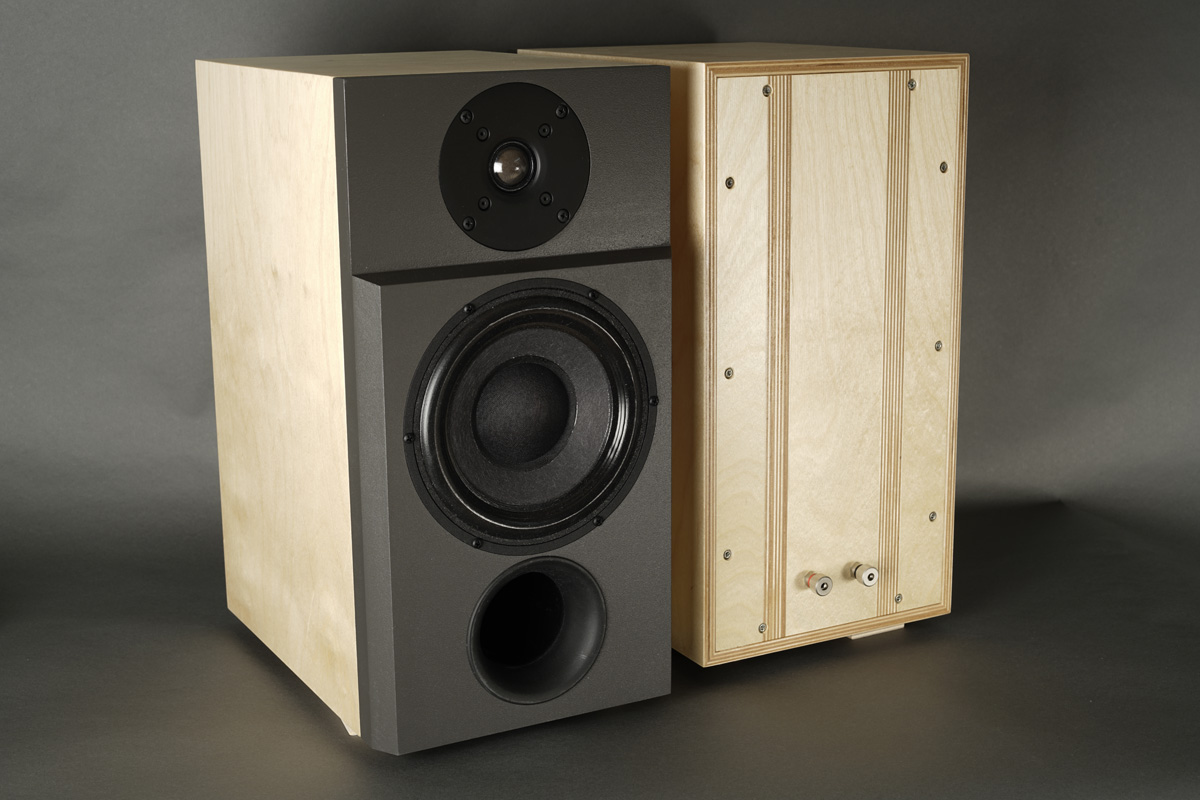
Potent bass module for the STUDIO 101 mkII
BACK TO INDEX
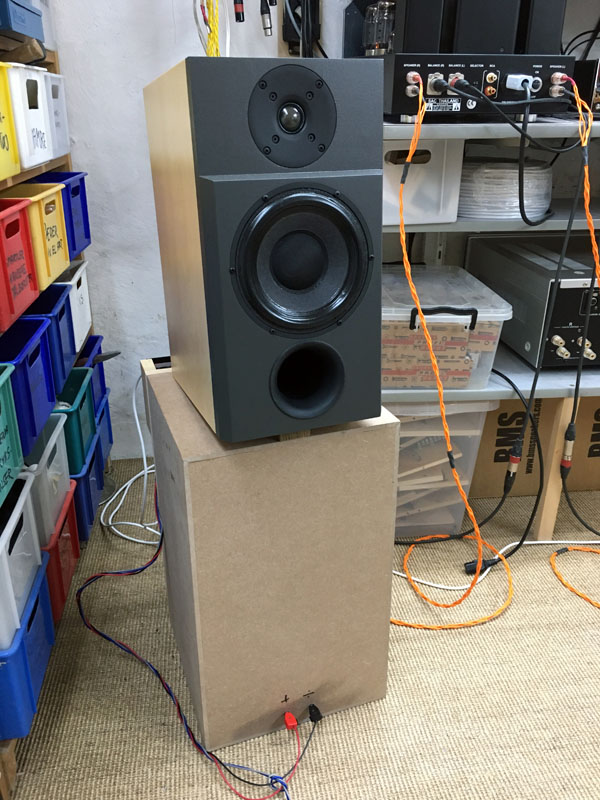
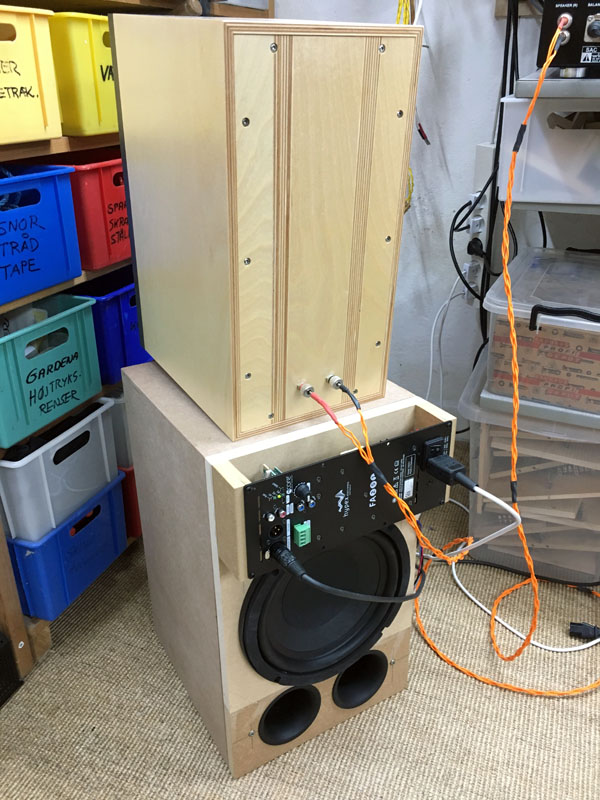
During STUDIO 101-mkII construction I - for fun - placed a Faital
10RS350 bass drivers in my 34 litre test cabinets, gave them 2 x Ø68 x
220 mm ports and the plate-amp/DSP Hypex FA251.
The Faital driver can he had here:
https://www.lean-business.co.uk/eshop/faitalpro-10rs350 (GREAT
driver for 110 EUR).
10RS350 (8Ohm) datasheet here:
10RS350-8
See the finished bass module here.
Should you aim at more and deeper bass, try the ScanSpeak 28W/4878T01:
28W-4878T01.pdf
Have fun!
